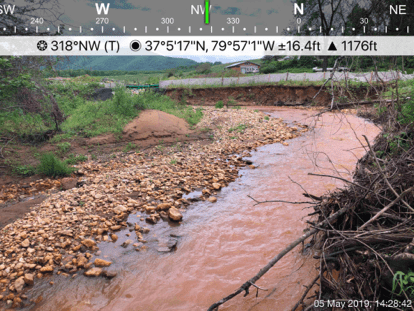
Water Turbidity Standards in Virginia and West Virginia
In a new report, Trout Unlimited (TU) and West Virginia Rivers Coalition (WVRC) have teamed up to put forth a set of recommendations for the creation and enforcement of effective numeric turbidity standards. Throughout recent years, Virginia and West Virginia wildlife and ecosystems have been seriously threatened by various pipeline projects, most notably, the Mountain Valley Pipeline. These pipeline projects require crossings of many streams and rivers as well as the excavation of watersheds affecting these waterbodies. Moreover, much of the terrain of these areas is easily erodible, meaning that any excavation causes a large amount of sediment pollution in the waterways. This not only affects the wildlife within the streams but also the thousands of people that use the water for drinking and other purposes.
A primary measure in place to protect these waterways from pollution is the use of best management practices (BMPs), implemented by the pipeline companies, as well as various sediment-related standards set by state governments. These standards are categorized as either numeric standards, which quantify how much pollution can be in the waterways until they are no longer safe, or as narrative water quality standards, which give a qualitative explanation on how much sediment can or cannot be visible in rivers until it becomes harmful.
West Virginia has both numeric standards and narrative water quality standards, while current Virginia narrative standards prohibit distinctly visible floating or settleable solids, suspended solids, scum, foam, or oily slicks. However, Virginia has no numeric water quality standard for sediment to supplement the narrative requirement. So while pipeline companies are required to create certain BMPs to enforce both of West Virginia’s standards, the lack of Virginia’s numeric standard allows the pipeline to get away with significantly loser BMPs.
TU and WVRC make the case that numeric water quality standards provide a better tool for agencies to protect wildlife in Virginia and West Virginia. Turbidity that is caused by sediment displacement and erosion in rivers and streams has already been seen in various scientific case studies to adversely affect fish and invertebrates. By continuing to allow Virginia to remain without adequate numeric standards that protect wildlife in waterways as well as the state’s drinking water, state officials are acting irresponsibly. Citizens have already submitted hundreds of complaints to state agencies documenting sediment pollution and insufficient pollution controls that resulted in violations being issued to pipeline companies requiring them to step up their sediment controls. However, without the development of these numeric standards, these violations will continue to occur.
The report recommends that the Virginia Department of Environmental Quality prioritize the development of numeric turbidity criteria that protect existing and designated stream uses and that regulators begin “enforcement of already established numeric turbidity standards in West Virginia.” Both of these recommendations are feasible and should be adopted by the respective state agencies, for the sake of wildlife and human safety.